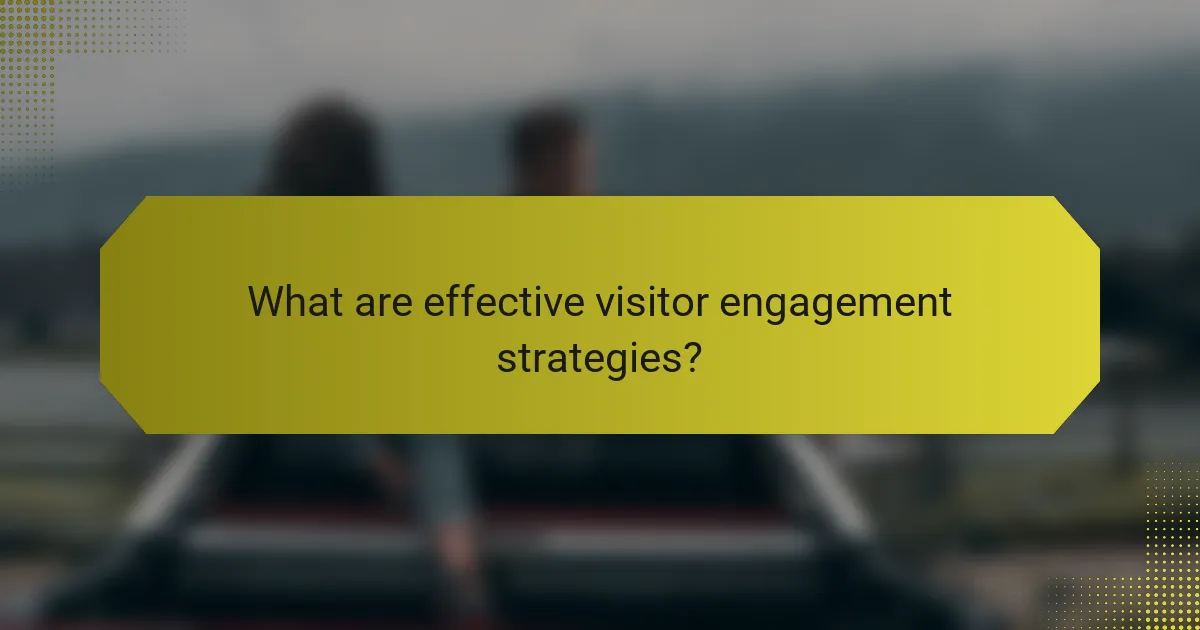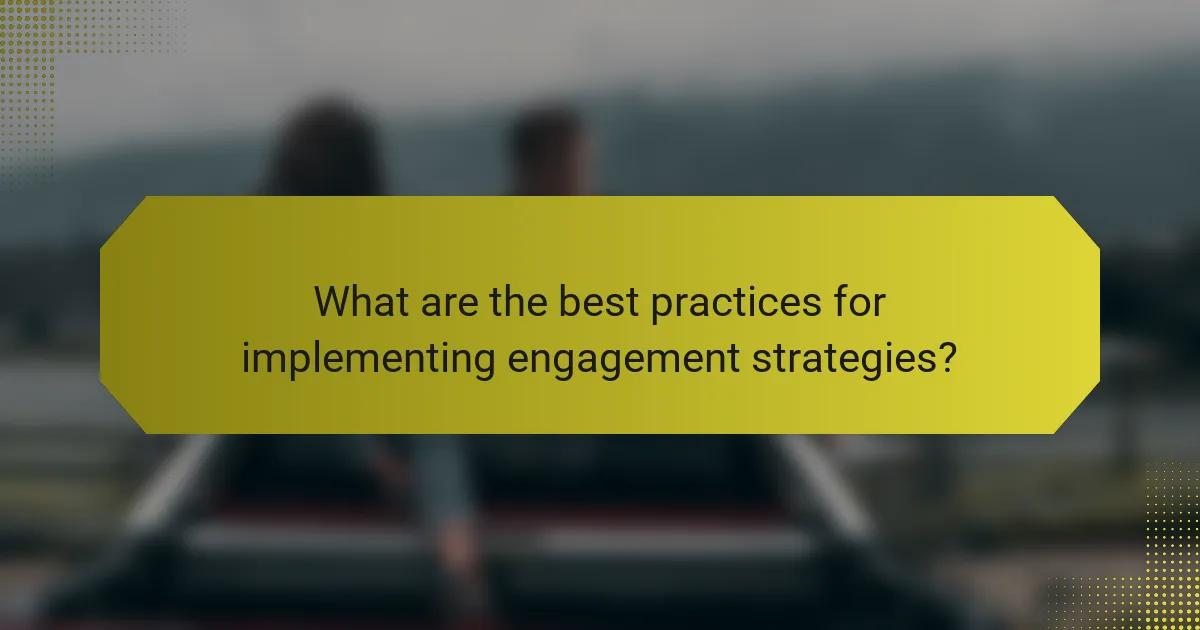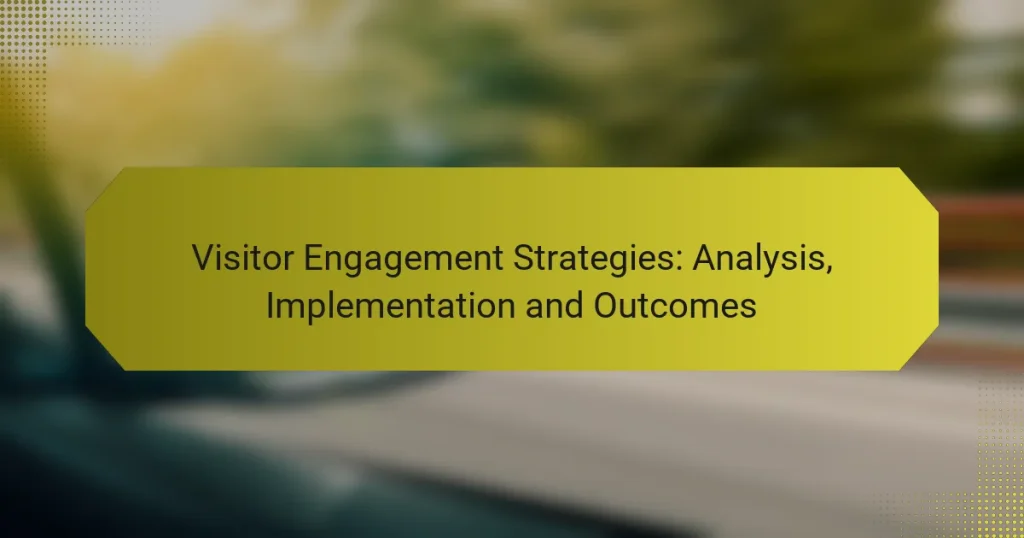Visitor engagement strategies are essential for fostering meaningful interactions that enhance user experience and satisfaction. By analyzing visitor behavior and preferences through various methods, organizations can implement targeted strategies that lead to increased retention and stronger brand relationships. With a focus on clear objectives and continuous improvement, these strategies can significantly drive desired outcomes for both visitors and organizations.

What are effective visitor engagement strategies?
Effective visitor engagement strategies are techniques designed to enhance interaction and connection with users, ultimately improving their experience and satisfaction. These strategies can lead to increased retention, higher conversion rates, and a stronger relationship between visitors and the brand.
Personalized content experiences
Personalized content experiences tailor information and offers to individual users based on their preferences and behaviors. This can include product recommendations, customized landing pages, or targeted messaging that resonates with specific audience segments.
To implement this, utilize data analytics tools to gather insights on user behavior and preferences. Consider A/B testing different content variations to determine what resonates best with your audience.
Interactive elements like polls and quizzes
Interactive elements such as polls and quizzes engage visitors by encouraging participation and providing immediate feedback. These tools not only make the experience more enjoyable but also gather valuable insights about user preferences and opinions.
Incorporate simple, visually appealing quizzes related to your content or industry. Ensure they are easy to complete and share results on social media to extend engagement beyond your site.
Social media integration
Integrating social media into your engagement strategy allows visitors to share content easily and connect with your brand on multiple platforms. This can enhance visibility and foster a community around your brand.
Utilize social sharing buttons on your content and encourage users to follow your social profiles for updates. Consider running social media contests or campaigns that incentivize sharing and participation.
Email marketing campaigns
Email marketing campaigns are a direct way to engage visitors by delivering personalized content and offers straight to their inbox. This method can nurture leads and keep your audience informed about new products or events.
Segment your email list based on user behavior and preferences to send targeted messages. Use compelling subject lines and clear calls to action to increase open and click-through rates.
Gamification techniques
Gamification techniques incorporate game-like elements into the user experience to motivate and engage visitors. This can include rewards, points systems, or challenges that encourage users to interact more deeply with your content.
Implement features such as leaderboards or achievement badges to create a competitive yet fun environment. Ensure that the gamification elements align with your brand and provide real value to the user experience.

How can visitor engagement be analyzed?
Visitor engagement can be analyzed through various methods that provide insights into user behavior and preferences. By employing analytics tools, tracking user interactions, and gathering feedback, organizations can better understand how visitors interact with their content and services.
Utilizing analytics tools like Google Analytics
Google Analytics is a powerful tool for analyzing visitor engagement. It tracks metrics such as page views, session duration, and bounce rates, allowing organizations to see how users navigate their site. By setting up goals and conversion tracking, businesses can measure the effectiveness of their engagement strategies.
To maximize the benefits of Google Analytics, ensure that your tracking codes are correctly implemented on all pages. Regularly review your reports to identify trends and areas for improvement. Consider segmenting your audience based on demographics or behavior for more targeted insights.
Heatmaps for user behavior tracking
Heatmaps visually represent where users click, scroll, and spend time on a webpage. This data helps identify which areas of a site attract attention and which are ignored. By analyzing heatmaps, organizations can optimize their layouts and content placement to enhance user engagement.
Implementing heatmap tools like Hotjar or Crazy Egg can provide actionable insights. Look for patterns in user behavior, such as frequent clicks on non-clickable elements, which may indicate confusion. Adjust your design based on these insights to improve navigation and user experience.
Surveys and feedback forms
Surveys and feedback forms are direct methods for gathering visitor opinions and experiences. By asking targeted questions, organizations can gain valuable insights into user satisfaction and areas needing improvement. Consider using tools like SurveyMonkey or Google Forms to create and distribute surveys easily.
To increase response rates, keep surveys short and focused. Offer incentives, such as discounts or entry into a prize draw, to encourage participation. Regularly analyze feedback to identify trends and implement changes that enhance visitor engagement.

What are the best practices for implementing engagement strategies?
Effective engagement strategies are built on clear objectives, audience understanding, and continuous improvement. By focusing on these elements, organizations can foster meaningful interactions that enhance visitor experiences and drive desired outcomes.
Setting clear engagement goals
Establishing clear engagement goals is crucial for guiding strategy development. Goals should be specific, measurable, achievable, relevant, and time-bound (SMART) to ensure they provide a solid foundation for your efforts.
For example, a goal could be to increase visitor interaction on a website by 20% over six months. This clarity helps teams align their activities and measure success effectively.
Segmenting audience for targeted approaches
Segmenting your audience allows for tailored engagement strategies that resonate with different groups. By analyzing demographics, behaviors, and preferences, organizations can create personalized experiences that enhance relevance.
For instance, a travel website might segment users by interests such as adventure, relaxation, or culture, allowing for targeted content and promotions that appeal specifically to each group.
Testing and optimizing strategies
Regular testing and optimization are essential for refining engagement strategies. Implement A/B testing to compare different approaches and identify what resonates best with your audience.
Monitor key performance indicators (KPIs) such as click-through rates and conversion rates to assess effectiveness. Use this data to make informed adjustments, ensuring your strategies remain relevant and impactful over time.

What outcomes can be expected from improved visitor engagement?
Improved visitor engagement can lead to several positive outcomes, including increased conversion rates, higher customer retention, and enhanced brand loyalty. These benefits arise from creating a more personalized and interactive experience that resonates with visitors.
Increased conversion rates
Higher visitor engagement typically results in increased conversion rates, as engaged visitors are more likely to take desired actions, such as making a purchase or signing up for a newsletter. Strategies like personalized content, interactive elements, and clear calls to action can significantly influence these rates.
For example, e-commerce websites that implement live chat features often see conversion rates rise by a noticeable margin, as customers receive immediate assistance. Testing different engagement tactics can help identify what resonates best with your audience.
Higher customer retention
Improved visitor engagement fosters higher customer retention by creating a more satisfying experience that encourages repeat visits. Engaged customers are more likely to return, as they feel valued and connected to the brand.
To enhance retention, consider implementing loyalty programs or personalized follow-up communications. For instance, sending tailored recommendations based on previous purchases can keep customers interested and coming back for more.
Enhanced brand loyalty
Visitor engagement plays a crucial role in building brand loyalty, as engaged customers develop a stronger emotional connection to the brand. This loyalty often translates into long-term relationships and advocacy, where customers actively promote the brand to others.
To cultivate brand loyalty, focus on delivering consistent and meaningful interactions across all touchpoints. Engaging customers through social media, personalized emails, and community-building initiatives can strengthen their commitment to your brand.

What criteria should be considered when choosing engagement tools?
When selecting engagement tools, consider their integration capabilities, cost-effectiveness, and how well they align with your specific goals. These criteria help ensure that the tools enhance visitor interaction without unnecessary complexity or expense.
Integration capabilities with existing platforms
Integration capabilities are crucial as they determine how well new engagement tools can work with your current systems, such as CRM, email marketing, or analytics platforms. Look for tools that offer APIs or built-in integrations to streamline data sharing and enhance user experience.
For example, if your website uses a popular content management system, choose engagement tools that easily connect with it to avoid disruptions. A seamless integration can reduce the time needed for implementation and minimize the risk of data silos.
Cost-effectiveness of tools
Cost-effectiveness involves evaluating both the upfront costs and the long-term value of engagement tools. Assess whether the tools provide a good return on investment by improving visitor engagement and conversion rates.
Consider tools that offer tiered pricing plans or free trials, allowing you to test their effectiveness before committing financially. A budget range of a few hundred to a few thousand USD per month is common for small to medium-sized businesses, depending on the features required.

How does visitor engagement differ across various industries?
Visitor engagement varies significantly across industries due to differing customer expectations, interaction methods, and business goals. Each sector employs tailored strategies to enhance engagement, reflecting its unique characteristics and audience needs.
Retail industry engagement tactics
In the retail sector, engagement tactics often focus on personalized experiences and convenience. Retailers use loyalty programs, targeted promotions, and personalized recommendations to foster deeper connections with customers. For instance, offering discounts based on purchase history can significantly boost repeat visits.
Additionally, in-store experiences, such as interactive displays and knowledgeable staff, enhance customer engagement. Retailers should also leverage online channels, like social media and email marketing, to maintain ongoing communication with their audience, ensuring they remain top-of-mind.
Engagement strategies in the travel sector
The travel industry employs engagement strategies that emphasize storytelling and immersive experiences. Travel companies often use visually appealing content, such as videos and high-quality images, to inspire potential travelers. Engaging with customers through social media platforms allows for real-time interaction and feedback.
Moreover, personalized itineraries and tailored travel packages can enhance visitor engagement. Offering mobile apps that provide real-time updates and local recommendations also helps travelers feel more connected and informed during their journeys, ultimately leading to higher satisfaction and loyalty.


